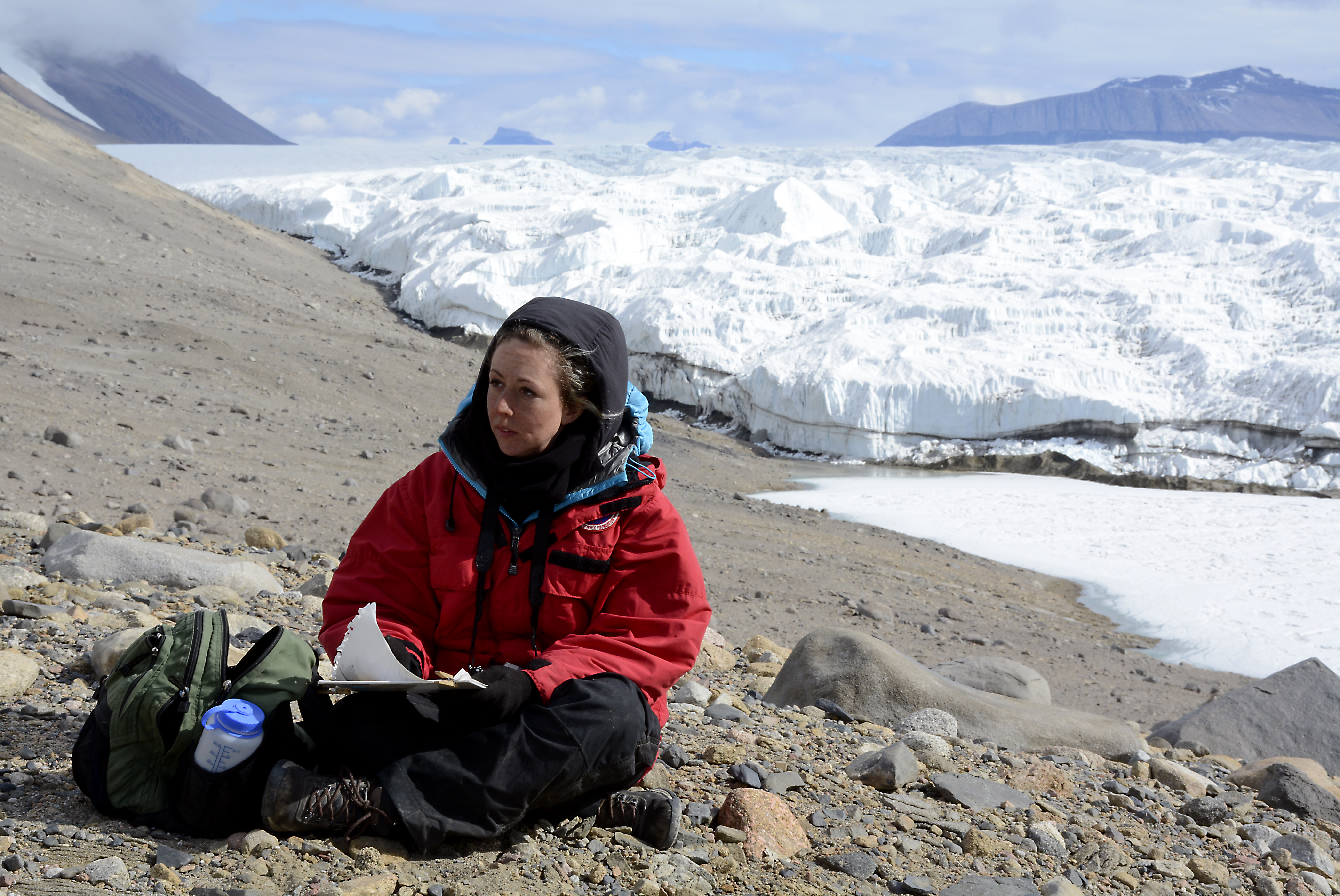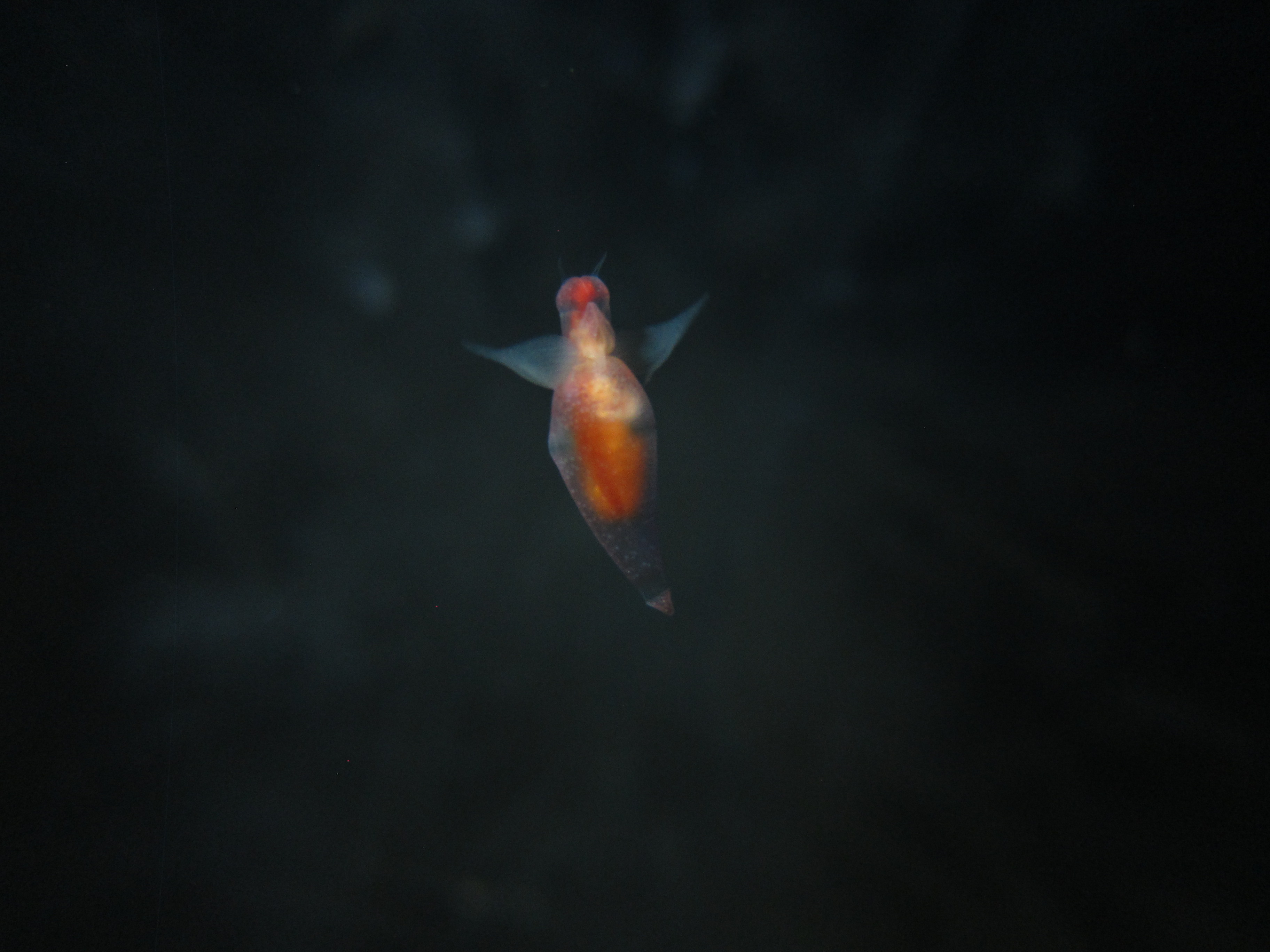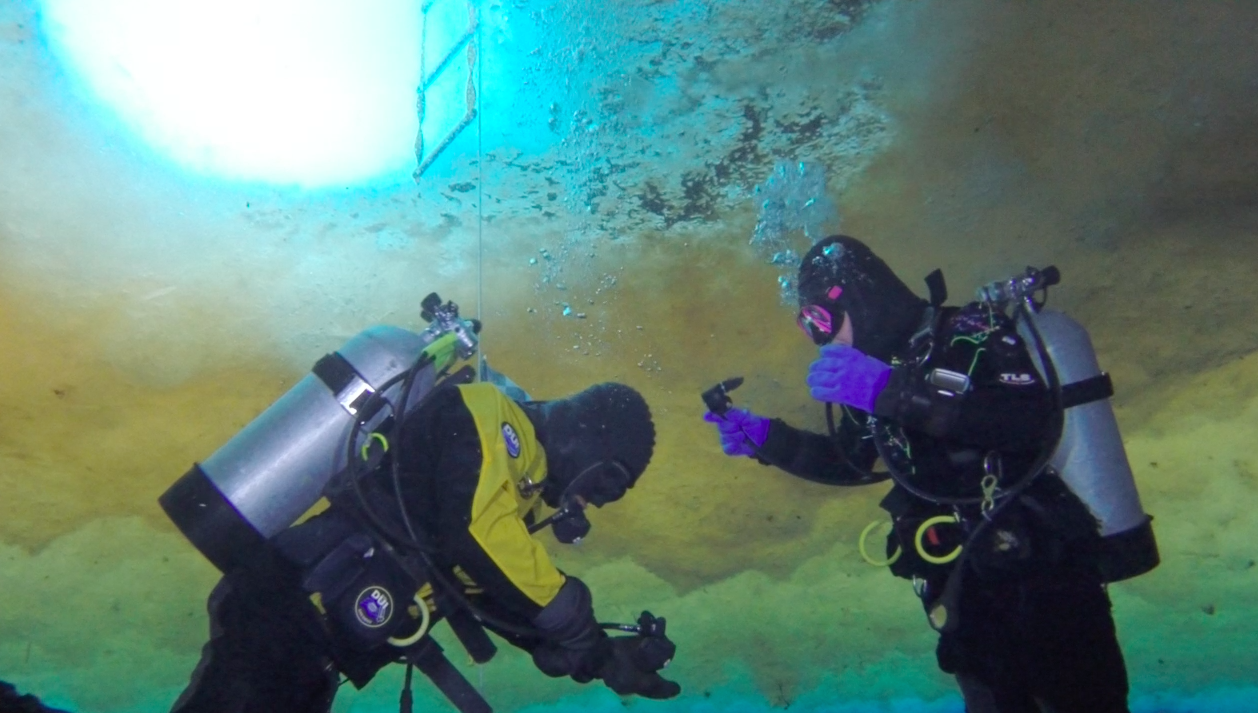When Lily Simonson packed her bags for a three-month National Science Foundation deployment to Antarctica this past October, she was sure to take extra pairs of long underwear and plenty of warm socks. She also brought sketchbooks, charcoal, a hundred square feet of canvas, and 25 gallons of oil paint.
Simonson, who is, at press time, wrapping up her tour on the continent, is the most recent participant in the NSF’s Antarctic Artists and Writers Program. For decades, this program has been sending professional creatives—poets, illustrators, sculptors, filmmakers, and musicians—to the icy south in an attempt to promote understanding of the least-explored land on Earth. Simonson, a Los Angeles-based painter, set out to make a study of biodiversity in the frigid waters of the McMurdo Sound and beneath the permafrost of the McMurdo Dry Valleys.
Archibald McMurdo, the British naval officer who served on the first ship to chart the area in 1841, was no doubt pleased to see his name splashed all over the continental map. But when people say “McMurdo” here, they’re probably talking about the main research station of the NSF-managed United States Antarctic Program, which operates scientific investigations and logistics in the region. Capable of hosting more than 1,200 people, the McMurdo complex has many of the infrastructural and cultural features that you’d expect to find in a small city: power and water facilities, a post office, a medical center, three bars, and a robust recreational program with yoga classes and movie screenings. The past year has seen a flurry of activity on Tinder.
Artworks created alongside scientific investigations, and Simonson’s marine-life paintings in particular, Thurber says, can help their audiences “appreciate environments that really are out of the reach of the vast majority of the world’s populace.”
Given the beleaguered state of science in the American political sphere—particularly science dealing with climate change, as so much polar research does—it seems surprising that the federal government is supporting artists in the scientific milieu. But consider these artists as modern-day participants in a tradition dating to the earliest days of Antarctic exploration, and it makes perfect sense.

In the first polar expeditions, as now, artists didn’t come along merely to indulge creative whims. Well into the 20th century, the Antarctic continent was literally uncharted territory. Artists were needed not only to describe new discoveries, but also to help generate interest in the journeys, which, as naval support diminished over the years, became increasingly dependent on private funding. “By 1914,” writes historian Stephanie Barczewski in her book Antarctic Destinies: Scott, Shackleton, and the Changing Face of Heroism, “it was recognized that visual images were a necessary feature of the lecture tours that all explorers were forced to undertake to pay off their expeditions’ inevitable debts.” These images included delicate watercolors by natural historian Edward Wilson and the now-iconic photographs and films of Herbert Ponting and Frank Hurley.
There was also a sense in which early explorers turned to creative endeavors to keep sane over the long, dark winters, and, Barczewski points out, as a “useful exercise in team-building.” Shackleton famously brought a printing press along on the 1907-09 Nimrod expedition. Aurora Australis, bound in dismantled packing crates, became the first book produced on the continent.

Research excursions in the following decades often included photographers, some of whose work is still being used today. (Recent extraction of 3-D data from a cache of 1940s and ’50s aerial photos is allowing scientists to map long-term changes in the continent’s glaciers.) Occasionally, a poet or historian or visual artist would come along. But it wasn’t until the 1980s, after years of campaigning by visionary NSF program manager Guy Guthridge, that the U.S. Antarctic Artists and Writers Program took shape.
These days, the program sends one or two participants to the ice each year, not so much for documentary purposes as for interpretive ones—to “translate” the work of the scientists to a broader audience, according to Peter West, outreach and education program manager for the NSF’s Division of Polar Programs. To do so, applicants go through a rigorous application process in which their proposals are committee-evaluated on the dual criteria of intellectual merit and broader impact, just as NSF scientists’ are.
West is strenuous in his assertions that the program does not issue awards lightly. Despite his affable manner, one gets the sense while speaking to him that he has a lot of experience fielding irate questions from skeptical politicians. For one thing, hopeful participants must demonstrate that it is necessary—“not desirable, not advantageous, but necessary,” he says—to conduct their projects in Antarctica. Nor does the program provide grants. “We support people on an in-kind basis,” West maintains, “but no one receives any funding through the Artists and Writers Program.” This means that artists are brought to Antarctica in the same planes that bring the scientists, housed on the same bases, and provided with the same food and protective clothing, but that they don’t receive any money for their time, materials, or creations. The real gift of the Artists and Writers Program is access.

Simonson has been fascinated by marine invertebrates since childhood. While other kids were drawing princesses and cars, the young Lily was filling her sketchpads with lobsters. She went on to earn arts degrees from Berkeley and the University of California-Los Angeles, where her painting focused, for the most part, on crustaceans and moths. Today, her aesthetic attractions continue to run to the obscure.
Gretchen Hofmann, a marine biologist at the University of California-Santa Barbara who recently worked with Lily on the ice, describes a scene from a dive graced by a pod of seals: “The dive master with her kept saying, ‘Lily, Lily, look at the seals!’ and she kept saying, ‘No no no! Look at the sea squirts!’” (Sea squirts are tunicates, small, vaguely floral-looking underwater creatures that spend their lives attached to rocks in clumps.) “She’s calibrated differently than a lot of people,” Hofmann says.
But it would be a mistake to chalk these enthusiasms up to mere eccentricity. For one thing, Simonson is solid in her science; she describes geological features and chemosynthesis among denizens of underwater methane seeps with equal aplomb. And she’s no slouch when it comes to fieldwork. All of the specimens that she paints, she collects herself. That Antarctic plunge with the sea squirts followed a harrowing certification procedure requiring over 50 dives—many of them in a drysuit, an impermeable, insulating get-up that Simonson describes as “astronaut-like” and “a sleeping bag with limbs,” and into and out of which she wriggled twice daily to complete 25 dives in her first few weeks on the continent.

Once qualified, divers in the Antarctic are rewarded with the best visibility in the world and an eerie, dramatic landscape. Under the ice, Simonson found herself enchanted by “the feathery quality of the platelet ice, the gold-green-turquoise gradation in the sea ice created by the microalgae growing in it, the steep volcanic dropoffs of the sea floor, and the huge glowing brine channels.” The ghostly marine landscapes, and the animals that inhabit them, have given new direction to her work.
Simonson’s paintings are a bit uncanny, with the luminous and sometimes grotesque quality of old Dutch still lifes. They’re also very large, representing in mural-sized canvases creatures that are often no bigger than a few inches. She uses this intensely magnified scale to emphasize her subjects’ weird and unsettling, yet inviting, qualities. “These organisms that seem sort of alien-like and are thriving in extreme habitats where it seems like organisms shouldn’t be able to thrive—there’s something otherworldly about them,” she says. “But then, by making them sort of human-sized … I’m highlighting the ways in which they’re kindred.”
In some ways, painting in Antarctica is just like painting anywhere else. Simonson has access to a small studio at McMurdo, not far from the rooms where the specimens are stored. She keeps a cooler with her so that she can take some of the more robust creatures that she’s collected back to her workspace.
On the other hand, painting in Antarctica can be really hard. Outside, Simonson’s paints are only workable for 20 minutes before freezing. Sometimes, the wind sweeps the color off of her palette as soon as she loads it on. Wilson, over a century ago, would be able to relate to these circumstances; like Simonson, he wound up making sketches on site and taking notes on which colors to use when he returned to base camp. At least Simonson doesn’t have to dose her eyes with liquid cocaine, as Wilson did nightly, Barczewski says, to soothe his snow blindness.
In some sense, Simonson’s work here recapitulates that undertaken by the earliest explorers, and she readily acknowledges the influence that historical scientific illustration has had on her work. At the same time, the presence of newer, nimbler technologies better suited to capturing scientific information frees her from purely descriptive responsibilities. “I get to occupy a different space,” Simonson says. “I don’t just have to document the appearance and the morphology of the animal. I can bring something emotive to it and also bring something kinetic to it.” Those qualities are evident in her paintings, which seem to glow and float before the eye as something seen underwater.

It’s clear that Simonson’s voyage to the Antarctic—her second, actually, but her first with the Artists and Writers Program—has been a boon to her artwork. But is it mutual? Can scientists benefit from an artist in their midst? Andrew Thurber, an ocean ecologist at Oregon State University who has worked with Simonson and numerous other artists in the course of his research, thinks so. Artworks created alongside scientific investigations, and Simonson’s marine-life paintings in particular, he says, can help their audiences “appreciate environments that really are out of the reach of the vast majority of the world’s populace.” An appreciation that, in turn, serves another good. “The deep sea is an area that, if we can do anything to increase its visibility and increase people’s appreciation for it, it really benefits the globe,” Thurber says, “because it becomes an environment that people want to conserve.”

Simonson balks at drawing out the political aspects of her work. But they’re hard to avoid in any work of art. Even the Dutch still lifes, those feasts for the eye, are loaded with symbolism—in effect, she says, they’re a “Calvinist warning against excess.” Similarly, Simonson remarks of her deep-sea and Antarctic subjects that “these are both areas that are really remote and that are becoming affected by human activity, and the changes are results of the excesses of the first world.” While she’s careful to point out that her work isn’t intended to be didactic, Simonson, like other Antarctic artists before her, can get people to care about things that scientific reports aren’t always able to.
Simonson is finding her latest inspiration in the tiny sea snails called pteropods. For Gretchen Hofmann, who researches these animals, the attention that Simonson’s work can focus on them is vitally important. Hofmann laughingly acknowledges that her fauna of choice lack the charisma of penguins or seals when it comes to generating public interest. Like Thurber, she is quick to credit Simonson’s paintings with flourishing where words and diagrams sometimes fail. “It’s where art is so critical to science, Hofmann says. “She’s able to capture an essential component of why we’re doing this.”
Lead photo: Lily Simonson, Garwood Ice Cliff Antarctica No. 2. 2014. 72″ x 90″, oil, acrylic, and UV reactive pigment on canvas. (Photo: Courtesy Jay Oligny and CB1 Gallery)
*UPDATE — February 24, 2015: The photograph of the tiny pteropod Clione antarctica, the subject of Lily Simonson’s latest paintings, was originally attributed to Simonson. It was taken by Rob Robbins.




